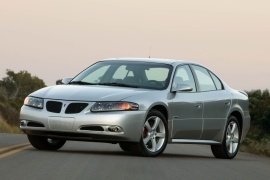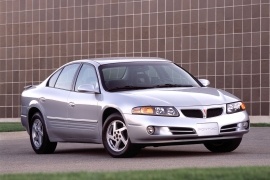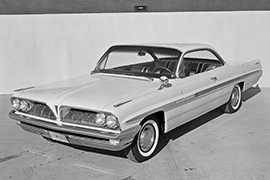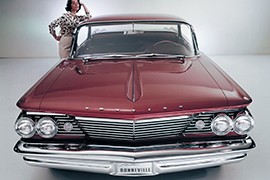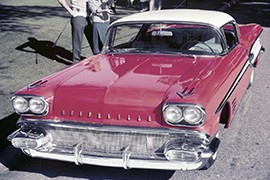PONTIAC Bonneville Models/Series Timeline, Specifications & Photos
First production year: 1958
Engines: Gasoline
It was the last refresh for the Pontiac Bonneville, a car which was on the market since 1958 and reached its tenth generation in 2000.
GM tried to find new ways to keep the Bonneville nameplate on the market and refreshed it in 2004 for the 2005 model year lineup. Along with the upgraded exterior and new materials for the interior, the car received a V-8 engine carried over from Cadillac. It was the first V-8 Bonneville after 17 years.
Pontiac insisted on keeping its wide stance on the road, and General Motors approved it. Thus, the Bonneville was the widest car built on the GM's G-Platform, which made the carmaker named it as an H-platform. At the front, a clear glass covered the three-lamp headlights, flanking the Pontiac-specific grille with a vertical slat in the middle. A re-designed wrapped-around plastic bumper featured two air-intakes, separated by a wide center element that sported the brand name.
Inside, the Bonneville kept the same design but with a different suede. It featured the same eight vents on the dashboard and the rounded design language. Its front bucket seats were more on the comfort side than on the sporty one. Since it was a full-size sedan, it provided enough room for three adult passengers on the rear bench, thanks to a small center tunnel. The GXP version instrument panel sported white dials with red needles to emphasize the car's sporty character.
Under the hood, apart from the previously used 3.8-liter V-6 naturally aspirated, Pontiac introduced a 4.6-liter Northstar V-8 powerplant that provided 275 hp. Its independent suspension in all corners and the wide track worked well during high-speed cornering, but its standard four-speed automatic transmission was not exactly what the car needed.
The tenth and last generation of the Bonneville saw the broad light in 2000 and shared its underpinnings with the Oldsmobile Aurora and the Cadillac Seville. It was designed for those who needed a family car but still enjoyed spirited driving.
Pontiac used to make sports-oriented vehicles, and that didn't change when it launched the 2000 model-year Bonneville. Unfortunately for the brand, the car was not that much appealing and managed to sell just about 12,000 units in its five years production time.
With its sharp front fascia and the specific Pontiac grille that took center stage, the Bonneville offered a menacing look. Its dual headlamps and corner-mounted turn signals formed wide headlights covered by clear glass. The ascending beltline formed a waved shape towards the back of the car, where the carmaker installed a wide connecting element between the taillights. Its greenhouse featured a raked windshield and a sloped rear window, while the deck sported a lip spoiler for the top trim level, the GXP.
Inside, the dashboard was centered around the driver, with an extended instrument cluster over the center stack that hosted the audio controls on the upper side, while the climate control unit was located on the driver's knee level. Thanks to its front-wheel drive system, the Bonneville provided plenty of room for four passengers, with bucket seats at the front and a bench profiled for two in the back.
Up until 2004, the car was offered with either a 3.8-liter V6 or a turbocharged version of the same powerplant. After that, the turbo version was replaced by the naturally-aspirated 4.6-liter V8 dubbed Northstar, which was already available on the Cadillac Seville. All versions sent the power to the front wheels via a four-speed automatic transmission.
Pontiac raced hard through Bonneville generations and, after just three years since it unveiled the first generation, the carmaker brought the third generation, which lasted only three years.
Made as the top of the line Pontiac in the stable, the Bonneville was already offered in a few body shapes such as coupe, convertible, a sedan with four doors, and station wagon. But it was the coupe that ignited the car-buyers to the Bonneville, which didn't change in three years.
The 1961 model featured a far more different design than the original 1958 model. The space-race theme designs were gone, and so were the flamboyant, curved panels. The 1961 generation featured a cleaner design, with flat panels and long lines. At the front, the designers kept the dual-headlamps system placed horizontally on the grille. A pinned-out center area sported the red Pontiac badge. From its sides, the designers made the sideline with an up kick behind the doors and continued to the end of the rear quarter panels.
Inside, Pontiac installed a bench at the front and one in the rear. Since it was the most exclusive car from its stable, it made it looks exquisite. The vinyl upholstery was completed by the walnut veneer trim from the instrument panel and door panels. On the lower side of the cabin, the carmaker installed carpeted door panels in the same color as the floor mats. The coupe featured air-conditioning, a radio, power steering and brakes, and interior lights.
Unlike the 1958 Bonneville, the 1961 model featured a choice of two engines with a 6.4-liter and a 6.9-liter displacement, but with the power ranged between 235 hp and 405 hp.
It was born before the muscle-car era began and was available as a coupe and a convertible. It was a blue-collar hero of affordable speed within GM.
The space-age design era was already there, and the American car designers tried hard to put rocket-like taillights and big (bigger) fins at the back of the car. While doing this, the engineers tried harder to make the cars lighter, and, somehow, the Bonneville Coupe was the winner in its class. And it held its hero-car status until the mid-'60s.
Pontiac introduced the Bonneville as a sport-coupe vehicle in its lineup, and that's why the designers tried to make the car look sleeker than its predecessor. They imagined straight lines that stretched along with the bodywork and a tilted-forward design for the greenhouse. At the front, the double-rounded headlights were separated by a wide, pined-out, chromed grille. The sculptured side panels featured chromed slats emphasizing the sporty look of the car.
Inside, Pontiac made a long list of standard features and even a longer one for the options. It included a three-speed automatic gearbox, an air-conditioning system, and even bucket-seats instead of the front occupants' standard bench. A wood-trim on the dash and door-panels gave the idea of a luxury vehicle, while the leather-wrapped seats were available as an option.
Under the hood, Pontiac installed a 6.4-liter V8 available in two power options, depending on the carburetor system. The wide-track design gave the car an edge over its competitors in the handling department. Moreover, an LSD differential was available on the options list.
The Bonneville nameplate appeared on the Star Chief lineup as a trim level, but in 1958 Pontiac introduced it as a separate, personal luxury coupe model.
Born in the times of the Space Race between the U.S. and Soviet Union, Bonneville featured plenty of rocket-inspired elements. Pontiac also put more chrome on that car than other carmakers placed on their entire range. It was built to celebrate both the GM's 50th anniversary and the retirement of the designer Harley Earl from the company.
The striking '50s styling showed a dual headlamps system for the headlights. They were placed above the vast, side-to-side, chromed grille. At the lower side, a shiny bumper adorned with oval-shaped parking lights completed the imposing presence of Bonneville. On top of the front fenders, the carmaker placed rocket-inspired decorations and, from the sides, Pontiac used the same theme to enhance the car's profile. The long coupe sported a small ground clearance for its times. In the back, the double round red taillights resembled the same rocket-inspired theme for the coupe.
Pontiac installed a luxurious interior with silver sparkles embedded in the floor carpets. At the front, there was a wide bench where three people could sit comfortably, maybe just touching their elbows. In the back, the Bonneville featured another three-person bench, with a unique feature for the middle seat. When it was not used, the middle section could have been popped up and used as an armrest.
Under the hood, Pontiac installed a single V-8 engine but offered six power outputs ranging between 255 hp to 355 hp for the Tri-Power option (triple two-barrel carburetors). Most Bonnevilles came with a 4-speed Hydramatic automatic, though a small number had a 3-speed manual.
